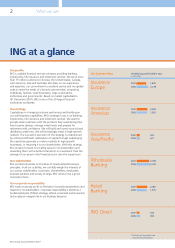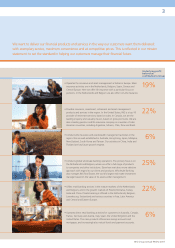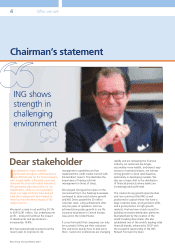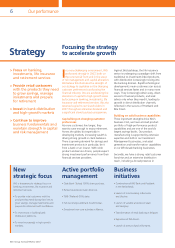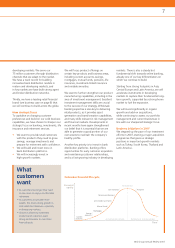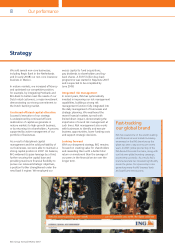ING Direct 2007 Annual Report Download - page 14
Download and view the complete annual report
Please find page 14 of the 2007 ING Direct annual report below. You can navigate through the pages in the report by either clicking on the pages listed below, or by using the keyword search tool below to find specific information within the annual report.
The year saw a good deal of
turbulence on the financial markets,
beginning with concerns over US
subprime mortgages. This put a spotlight
on risk management across the financial
sector. The crisis had only a limited impact
on the profit and loss account, through our
investments in pressurised asset classes.
This is the result of the close management
partnership that exists between risk
managers and the business lines.
The purpose of Risk Management is to
build a sustainable competitive advantage,
by fully integrating risk management
activities into daily business activities and
strategic planning. Risk Management
supports business activities in three
important ways. We help identify growth
opportunities. We help to provide lower
costs of risk and funding, and more
efficient capitalisation. And we support
decision-making, by providing insights into
the trade-offs between risk, return and
growth opportunities.
ING’s solid risk management and strong
liquidity position have helped shield it from
the turmoil on the credit and financial
markets during 2007, with relatively minor
impact in terms of credit losses and
decreases in fair values relating to ING
Group’s investment and trading portfolios.
Our exposure to these pressurised asset
classes has been limited and is of high quality.
The direct negative P&L impact on ING
as a result of exposures in US subprime
Residential Mortgage Backed Securities
(RMBS), Collateralized Debt Obligations /
Collateralized Loan Obligations (CDOs/
CLOs), investments in Structured
Investment Vehicles (SIVs) and Asset-
Backed Commercial Paper (ABCP),
monoline insurers, and leveraged finance
was EUR 255 million pre-tax (EUR 61 million
in the third quarter and 194 million in the
fourth quarter). Pre-tax revaluation for the
pressurised asset classes (US subprime
RMBS, Alt-A RMBS and CDOs/CLOs) at
year-end 2007 was EUR –1,377 million.
On an after-tax basis this runs through
shareholders’ equity in the balance sheet.
ING managed the liquidity crisis
comfortably, given our balance sheet
strength and diversified funding base.
Investing to improve
In recent years, ING has systematically
invested in improving its risk management
capabilities. A necessary response to
increased investor demands, more
sophisticated regulation, more complex
technology, and the continued evolution of
secondary markets. After years of targeted
investments in people and technology, we
ended 2007 with around 4,500 dedicated
risk management employees.
Koos Timmermans
chief risk officer
In terms of risk, I see
three major success stories in
2007. First, comfortably
surviving the financial crisis,
both on the liquidity side but
also without being over-
extended on the credit side.
Second, our preparations for
Basel II compliance, which will
contribute to our being better
capital-aligned and more
capital-efficient. Third,
compliance: we now have
a real consensus about where
we are and where we’re going.
Prioritising non-financial risks
is one area where we can do
more. Do you spend more on,
say, compliance, encrypting
PCs or anti-fraud programmes?
We need to establish how we
assess non-financial risks on a
like-for-like basis, just as we do
financial risks.
12
Risk review
Our performance


